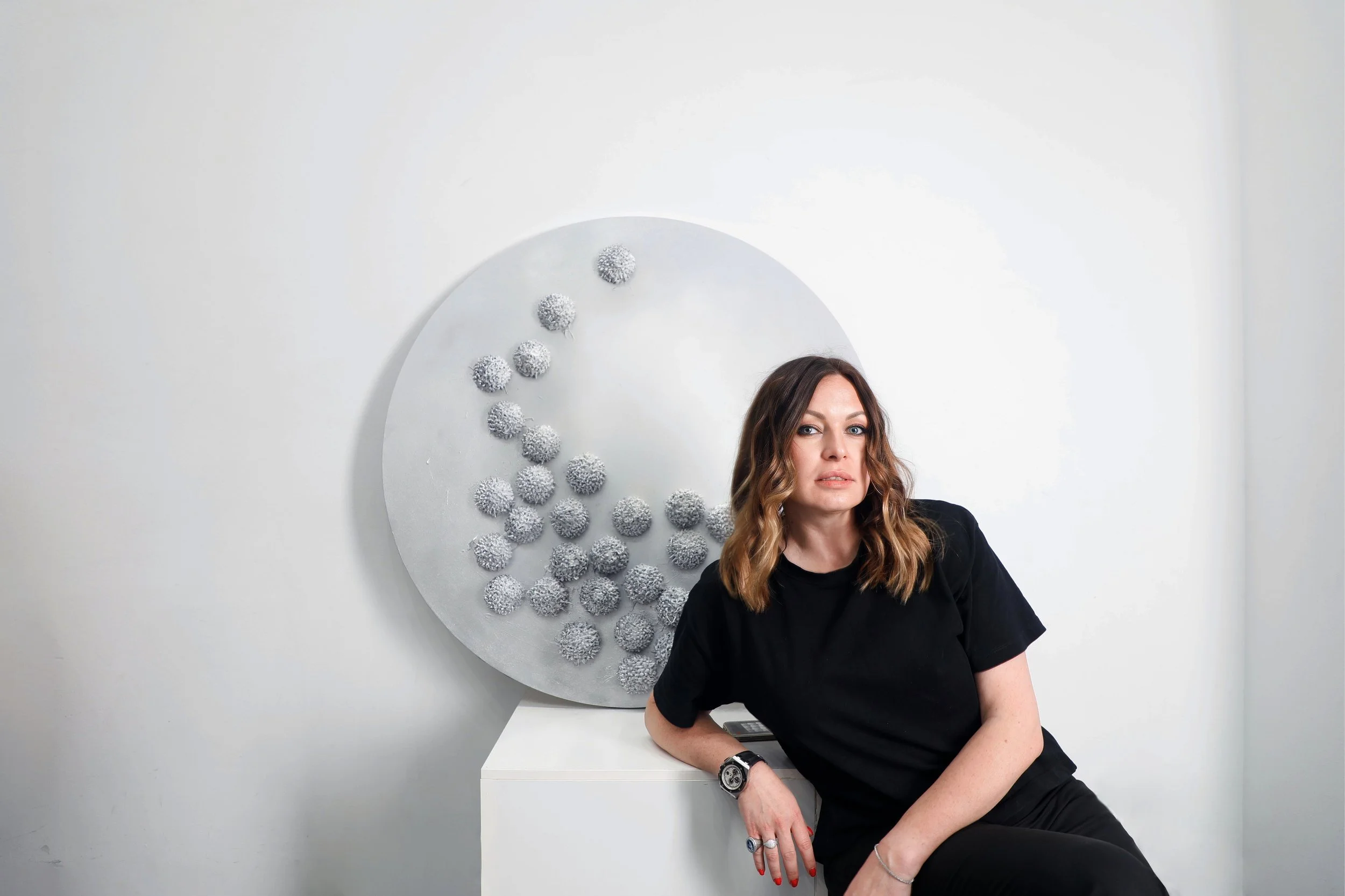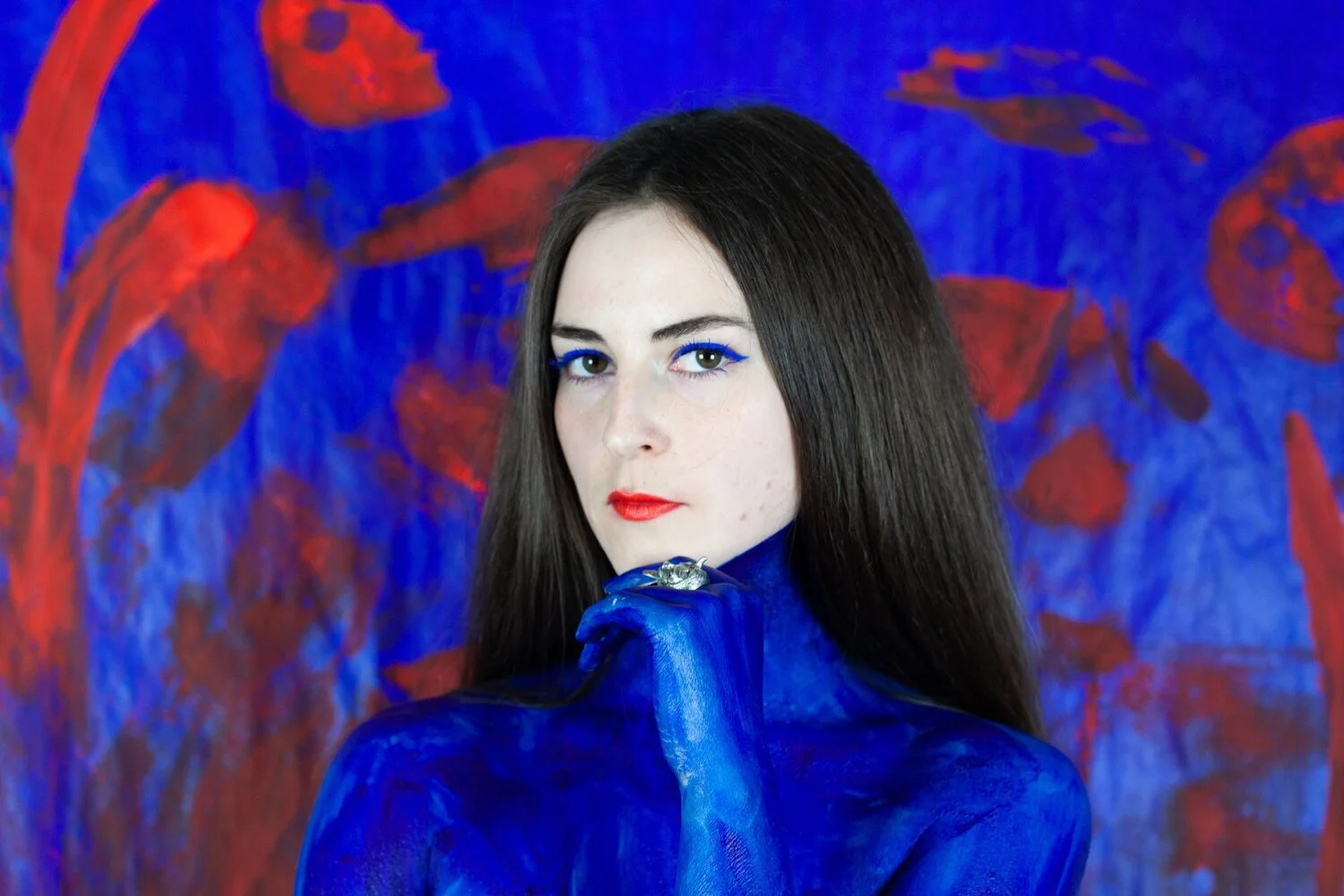9 Questions with Cheryl Safren
Cheryl Safren is a New Yorker artist featured in Al-Tiba9 magazine ISSUE04, interviewed by Mohamed Benhadj.
Cheryl Safren has abandoned traditional artistic materials altogether and creates art-employing chemical processes on metal. She cannot get enough of learning about new materials. and harnesses chemistry to create art. To most artists, experimentation is an essential part of finding their voice. For Safren, the process is a central aspect of any artist’s work, but the materials usually employed do not evolve as much as the artists do. Their evolution is supportive and coincident with the development of the project and the artist. Her art shifted when she discovered chemicals; she developed her own recipes. About her processes, she says: “It is challenging to describe my thinking process in words because my thoughts aren’t verbal. They are thoughts more than feelings ... they evolve and change as the work does almost as if I am in the process; it has become so organic for me that I sense how to move.”
Selected as one of two American artists for the international exhibition “Responding to Climate Change” held in Daejeon, Korea in 2017, Safren was a panelist at the New York “Women in Biology” event and a speaker and exhibitor in the Woman Forward: Innovative Women exhibit in Williamsburg, Brooklyn.
What kind of education or training helped you develop your skillset?
As a New Yorker who was born in Brooklyn and grew up in the Bronx, I attended the High School of Art & Design, then received my BFA from Pratt Institute, and my Master of Science from Hofstra University.
How did you start making art?
When my son was in middle school, we worked on a science project together for his school’s science fair. The project centered on submerging copper metal strips in various household liquids and then observing and recording what happened. My son got an A and then lost interest, while I became curious to see what happened when you used other chemicals and not just household things. My brother, who was a sculptor, at the time, had a book, The Colouring, Bronzing, and Patination of Metals by Richard Hughes and Michael Rowe. This book, a guide with recipes included, is the best-known source on the patination of metals. Other than inspiring my thinking, this book wasn’t beneficial to me for a few reasons. The recipes entail submerging the metal in various chemical brews and allowing them to marinate, sometimes heating them. This ultimately was unappealing because of its aesthetic limitations. I wasn’t interested in having an all-over surface texture. By submerging a metal panel, the entire panel will patinate, and I wanted to create imagery, not wallpaper. Also, the recipes in the book were highly toxic. I returned the book and began to experiment on my own. In time, I began experimenting with various oxidizing chemicals and corrosives. This was when I spoke with my cousin, a chemical engineer, to get some tips on safety. He suggested first mixing minute quantities so that I could maintain control. If I didn’t like the direction a reaction was taking, I could stop. I worked outside with a fire extinguisher and sand buckets at the ready. Also, I wore protective gear covering my face, hands, and feet. My earliest efforts employing chemistry on metals were executed outdoors in my backyard on a bed of sand. At such extreme temperatures, wood burns and concrete explodes. So outdoors, I choose to work on a bed of sand. I didn’t want the gases or chemical particles to linger in my home studio because of the intense heat necessary to execute some of this artwork, working in the summer requires specific considerations. All my materials were lined up by the studio door the night before. When the sun rose, I was outside setting up. By 9 a.m., it starts getting hot. I stopped to drink water so that I wouldn’t dehydrate, and then I would take a garden hose and thoroughly drench my body with water. I would work wet for as long as I could until it was too hot. Then I would clean up outside, shower and take a nap because the heat is physically draining. I would return to work before dusk. In the spring, working outdoors has its positives and negatives. It is a fragrant season, but the wind adversely affects safety considerations by blowing chemicals and flames about, as well as leaves and petals onto the work. I wanted more control than working outside would allow. I couldn’t work on rainy days. I couldn’t work on windy days. Finally, I had permission to use a garage for further chemical exploration, and I have been working in a garage ever since.
Where did you get your imagery from? What sources did you use?
While biology, astronomy, and the environment, both real and imagined, influence the subject of much of my work, it is the chemical interactions that give full expression to my images.
What is your creative process like?
Dynamic chemical processes on copper panels form my work.
Hours of research and experimentation have allowed me to control and manipulate chemicals to create these images. Some of the processes employed produce coarse and grainy textures, while others produce shiny or gossamer ones. Some of the colors generated on these copper panels are known as interference colors and are provided by a transparent oxide film deposited on the metal surface. The colors develop when part of the light striking the oxide surface reflects, and part passes through the film before reflecting off the metal below. When the delayed light reappears and combines with the surface light waves, they may either reinforce or cancel each other, generating a specific hue. The thickness of the oxide film dictates the color.
What do you see as the strengths of your pieces, visually or conceptually?
When the light dims or strikes at oblique angles, the color becomes saturated and majestic. Shifting light on the copper surface and viewer movement are the kinesthetic forces altering perception, allowing us to discover new and exciting things each time we view the work. I have several of these pieces hanging in my living room, and I get lost in thought watching the changes. The work looks different at different times of the day as the angle of the sun in the sky moves.
What aspect of your work do you pay particular attention to?
Like many artists, I was a daydreamer and would lose chunks of time lost in thought. However, when I started using chemistry as a means to produce my images, I had to train myself to be very present to avoid dangerous mishaps.
The most exciting/challenging project you worked for?
Exciting. The Korean Research Institute of Chemical Technology sponsored eight artists internationally to participate in the Responding to Climate Change exhibition in Daejeon. Before the show, the artists collaborated with South Korean scientists via Skype a few times. The resulting exhibition, performance, and catalog were extraordinary.
Any shows galleries or publications where readers can find your work?
Currently, I am exhibiting in two New York City venues. From March 12 – June 12, 2020, “Seeing Within: Art Inspired by Science,” is showing at The Samuel J. Wood Library at Weill Cornell Medical Center on 1300 York Avenue, New York, NY. My work is also on exhibit now until April 4 in Williamsburg Brooklyn at the 21 st Annual Salon Show, which is located at 135 Broadway. My artwork and articles about it can be viewed at my website Safren.com anytime. The same is true by visiting #cherylsafren on Instagram.
Share something that you would like the world to know about your work?
I apply a clear sealant to arrest the oxidation process and protect the surface of the copper. Placing the copper in an interior environment where temperature and humidity are controlled offers the best protection against patination and chromatic degradation. What you see in the images presented here are panels that are sealed to prevent further patination. Public art agencies and other patrons of my art want assurances that these copper panels will not change with time, and I have complied. But I also make panels that I do not seal. I allow the natural patina to form. On my web site, these works are called Live Paintings.
I want to paraphrase Valerie Monroe Shakespeare, owner of the (now defunct) Fulcrum Gallery, (located for many years on Broome St. in NYC), the sentiment she expresses here informs my live paintings. She states that there is an intrinsic contradiction in trying to freeze an idea “forever” in any medium. Time is the enemy of art attempting to capture an impression or concept for future appreciation, without actually considering the future of the substance on which the art is created. The survival of a work of art that does not incorporate time is a losing battle against the “ravages of time.” Future generations are relegated to peering through the glass at shadows of once-great art or viewing “masterpieces” recreated by the hands of restorers. This art becomes nothing but a legend. The future becomes a significant part of the art when its material is interfaced with the idea. Instead of fighting the elements of nature, in a doomed battle to remain static, the art is allowed to respond, creating a dialogue with time & becoming enriched by the effects of time. In this way, time adds a new dimension to the art. Whether colors change because of your vantage point, as happens in my sealed panels, or the texture changes, as in my unsealed works, my art provides an ever-changing show, and I continue to create work in both of these modes.




















